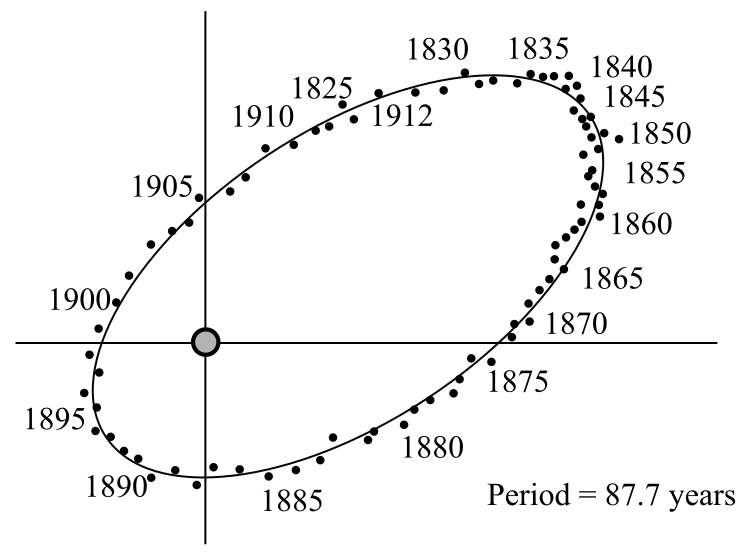
Concept explainers
(a)
The distance to the visual binary 70 Ophiuchi from the Earth in parsecs. It is given that the observed length of the semi major axis through a telescope is 4.5 arcsecs and the parallax angle of 70 Ophiuchi is 0.2 arcsecs.

(a)
Answer to Problem 68Q
Solution:
The distance of 70 Ophiuchi from the the Earth is 5 pc.
Explanation of Solution
Given data:
The observed length of the semi major axis through a telescope is 4.5 arcsecs and the parallax angle of 70 Ophiuchi is 0.2 arcsecs.
Formula used:
The expression for distance of a star in pc when its parallax angle is known is given blow.
Here,
Explanation:
The parallax method is very useful to find the distance of far off objects in the universe. By knowing the parallax angle of the object one can find out its distance from the point of observation.
Refer to the expression for distance of a star in pc when its parallax angle is known.
Substitute
Conclusion:
Hence, the distance of the visual binary 70 Ophiuchi from the Earth is 5 pc.
(b)
The length of the semi-major axis of the visual binary 70 Ophiuchi in astronomical unit. It is given that the observed length of the semi major axis through a telescope is 4.5 arcsecs and the parallax angle of 70 Ophiuchi is 0.2 arcsecs.

(b)
Answer to Problem 68Q
Solution:
The actual length of the semi-major axis is 22.5 au.
Explanation of Solution
Given data:
The apparent length of the semi-major axis when observed using a telescope is 4.5 arcsecs and the parallax angle of 70 Ophiuchi is 0.2 arcsecs.
Formula used:
Write the expression for distance of a star in pc when its parallax angle is known.
Here,
Write the expression of small-angle formula (when distance between the star and the observer is measured in pc and the apparent length is measured in arcsecs).
Here,
Explanation:
Use the distance between the observer and 70 Ophiuchi calculated using parallax method in the previous part to calculate the length of the semi-major axis.
Refer to the expression for actual length of semi-major axis.
Substitute
Conclusion:
Hence, the actual length of the semi-major axis of 70 Ophiuchi is 22.5 au.
(c)
The sum of the masses of the two stars in the visual binary 70 Ophiuchi in terms of the solar mass. It is given that the time period, the apparent length of the semi-major axis and the parallax angle of 70 Ophiuchi are 87.7 years, 4.5 arcsecs and 0.2 arcsecs, respectively.

(c)
Answer to Problem 68Q
Solution:
Explanation of Solution
Given data:
The time period, the apparent length of the semi-major axis and the parallax angle of 70 Ophiuchi are 87.7 years, 4.5 arcsecs and 0.2 arcsecs, respectively.
Formula used:
Write the expression for the distance of a star in pc when its parallax angle is known.
Here,
Write the small-angle formula (when distance between the star and the observer is measured in pc and the apparent length is measured in arcsecs).
Here,
Write the expression of Kepler’s third law for a binary star system.
Here,
Explanation:
Use the value of the actual length of the semi-major axis calculated in part (b).
Refer to the expression of Kepler’s third law and substitute this value of
Substitute
Conclusion:
Hence, the sum of the masses of the two stars in binary visual 70 Ophiuchi is
Want to see more full solutions like this?
Chapter 17 Solutions
EBK LOOSE-LEAF VERSION OF UNIVERSE
- Figure 29-43 Problem 12. ••13 In Fig. 29-44, point P₁ is at distance R = 13.1 cm on the perpendicular bisector of a straight wire of length L = 18.0 cm carrying current i = 58.2 mA. (Note that the wire is not long.) What is the magnitude of the magnetic field at P₁ due to i? P2° R R Larrow_forwardCheckpoint 1 The figure shows the current i in a single-loop circuit with a battery B and a resistance R (and wires of neg- ligible resistance). (a) Should the emf arrow at B be drawn pointing leftward or rightward? At points a, B C R b, and c, rank (b) the magnitude of the current, (c) the electric potential, and (d) the electric potential energy of the charge carriers, greatest first.arrow_forwardPls help ASAParrow_forward
- Pls help asaparrow_forwardPls help asaparrow_forward3. If the force of gravity stopped acting on the planets in our solar system, what would happen? a) They would spiral slowly towards the sun. b) They would continue in straight lines tangent to their orbits. c) They would continue to orbit the sun. d) They would fly straight away from the sun. e) They would spiral slowly away from the sun. 4. 1 The free-body diagram of a wagon being pulled along a horizontal surface is best represented by A F N B C 0 Ꭰ FN E a) A b) B c) C app app The app 10 app d) e) ס ח D E 10 apparrow_forward
 Foundations of Astronomy (MindTap Course List)PhysicsISBN:9781337399920Author:Michael A. Seeds, Dana BackmanPublisher:Cengage Learning
Foundations of Astronomy (MindTap Course List)PhysicsISBN:9781337399920Author:Michael A. Seeds, Dana BackmanPublisher:Cengage Learning Stars and Galaxies (MindTap Course List)PhysicsISBN:9781337399944Author:Michael A. SeedsPublisher:Cengage Learning
Stars and Galaxies (MindTap Course List)PhysicsISBN:9781337399944Author:Michael A. SeedsPublisher:Cengage Learning AstronomyPhysicsISBN:9781938168284Author:Andrew Fraknoi; David Morrison; Sidney C. WolffPublisher:OpenStax
AstronomyPhysicsISBN:9781938168284Author:Andrew Fraknoi; David Morrison; Sidney C. WolffPublisher:OpenStax
 An Introduction to Physical SciencePhysicsISBN:9781305079137Author:James Shipman, Jerry D. Wilson, Charles A. Higgins, Omar TorresPublisher:Cengage Learning
An Introduction to Physical SciencePhysicsISBN:9781305079137Author:James Shipman, Jerry D. Wilson, Charles A. Higgins, Omar TorresPublisher:Cengage Learning





